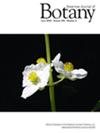Flooding stress influences productivity and modulates biodiversity effects in experimental grassland communities, shaping biodiversity–productivity relationships
Abstract
Premise
Biodiversity loss and increasing extreme weather events disrupt the functioning of ecosystems and thus their ability to provide services. While the interplay among various climatic constraints, diversity and productivity has received increasing attention in the last decades, the role of flooding has been overlooked.
Methods
In a greenhouse experiment, we manipulated species richness and water regimes to evaluate the influence of flooding on species diversity–productivity relationships. We measured biomass production and partitioned net biodiversity effects into complementarity and selection effects. To link changes in biodiversity effects to underlying mechanisms, we evaluated the contribution of species richness, species identity, functional diversity and community-level traits.
Results
Under flooding, biomass production decreased, and biodiversity effects were less frequently positive. By reducing the incidence of positive complementarity effects, flooding promoted a preponderance of selection effects. Flooding further favored competitive displacement by Phalaris arundinacea; balanced contributions to selection effects from all functional groups at field capacity subsided under flooding when P. arundinacea became the single dominant species. As a result, its acquisitive leaf trait attributes contributed more to selection effects and biomass production under flooding, while root traits contributed less to complementarity effects at field capacity.
Conclusions
As an environmental stressor, flooding promoted the dominance of tolerant species and reduced the incidence of complementary species interactions in the experimental plant communities, clearly modulating the linkage between diversity and productivity.

 求助内容:
求助内容: 应助结果提醒方式:
应助结果提醒方式:


